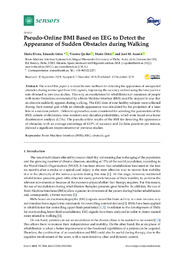Por favor, use este identificador para citar o enlazar este ítem:
https://hdl.handle.net/11000/6023Registro completo de metadatos
| Campo DC | Valor | Lengua/Idioma |
|---|---|---|
| dc.contributor.author | Elvira, María | - |
| dc.contributor.author | Láñez, E. | - |
| dc.contributor.author | Quiles Zamora, Vicente | - |
| dc.contributor.author | Ortiz, Mario | - |
| dc.contributor.author | Azorín Poveda, José María | - |
| dc.contributor.other | Departamentos de la UMH::Ingeniería de Sistemas y Automática | es |
| dc.date.accessioned | 2020-05-19T09:14:24Z | - |
| dc.date.available | 2020-05-19T09:14:24Z | - |
| dc.date.created | 2019-12-10 | - |
| dc.date.issued | 2020-05-19 | - |
| dc.identifier.issn | 1424-8220 | - |
| dc.identifier.uri | http://hdl.handle.net/11000/6023 | - |
| dc.description.abstract | The aim of this paper is to describe new methods for detecting the appearance of unexpected obstacles during normal gait from EEG signals, improving the accuracy and reducing the false positive rate obtained in previous studies. This way, an exoskeleton for rehabilitation or assistance of people with motor limitations commanded by a Brain-Machine Interface (BMI) could be stopped in case that an obstacle suddenly appears during walking. The EEG data of nine healthy subjects were collected during their normal gait while an obstacle appearance was simulated by the projection of a laser line in a random pattern. Different approaches were considered for selecting the parameters of the BMI: subsets of electrodes, time windows and classifier probabilities, which were based on a linear discriminant analysis (LDA). The pseudo-online results of the BMI for detecting the appearance of obstacles, with an average percentage of 63.9% of accuracy and 2.6 false positives per minute, showed a significant improvement over previous studies | es |
| dc.description.sponsorship | This research has been carried out in the framework of the project Walk—Controlling lower-limb exoskeletons by means of brain-machine interfaces to assist people with walking disabilities (RTI2018-096677-B-I00), funded by the Spanish Ministry of Science, Innovation and Universities, the Spanish State Agency of Research, and the European Union through the European Regional Development Fund. | - |
| dc.format | application/pdf | es |
| dc.format.extent | 17 | es |
| dc.language.iso | eng | es |
| dc.rights | info:eu-repo/semantics/openAccess | es |
| dc.subject | Brain-Machine Interface (BMI) | es |
| dc.subject | EEG | es |
| dc.subject | obstacle | es |
| dc.subject | gait | es |
| dc.subject.other | Ingeniería. Tecnología | es |
| dc.title | Pseudo-Online BMI Based on EEG to Detect the Appearance of Sudden Obstacles during Walking | es |
| dc.type | info:eu-repo/semantics/article | es |
| dc.identifier.doi | 10.3390/s19245444 | - |
| dc.relation.publisherversion | https://doi.org/10.3390/s19245444 | - |

Ver/Abrir:
sensors-19-05444-v2.pdf
2,15 MB
Adobe PDF
Compartir:
 La licencia se describe como: Atribución-NonComercial-NoDerivada 4.0 Internacional.
La licencia se describe como: Atribución-NonComercial-NoDerivada 4.0 Internacional.
.png)